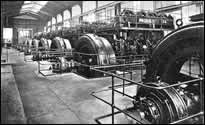
The works involved the diversion of 90% of the Shannon into a head race
canal 7.5 m long by which the water was delivered to Ardnacrusha, where
a fall of 34 m was available. After passing through the generators at the
power station the spent water was conveyed back to the Shannon by means
of a tail race canal. The chief Civil Engineer on the project was Frank
Sharman Rishworth from Tuam, who was at the time Professor of Civil Engineering
at UCG. On completion of the scheme considerable work was carried out on
developing the electricity grid, stretching the length and breadth of the
country. The construction of a transmission system for the entire country,
even very remote areas, was referred to as the "Rural Electrification
Programme".
In 1929 the Shannon Scheme was completed and handed
over to ESB. In its early years the station could practically support
the electricity needs of the entire nation. The highest proportion of
system demand supplied by Ardnacrusha was 87% in 1936/37. Ardnacrusha
was also the headquarters of ESB until 1954. By
2000 Ardnacrusha supplied only about 3% of the annual demand but it is
still vitally important to the system as a 'rapidly available' source
of power and for cover in cases of emergency or sudden breakdown of plant.


|

Temporary Power Generation Plant (1925-29) |

